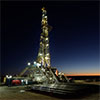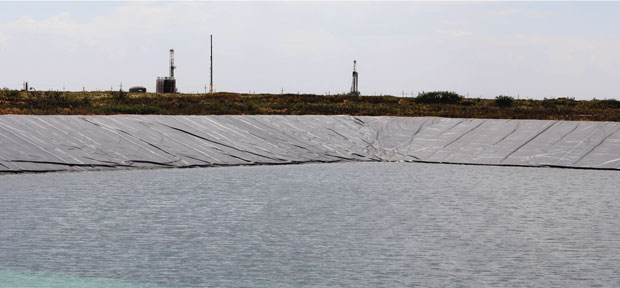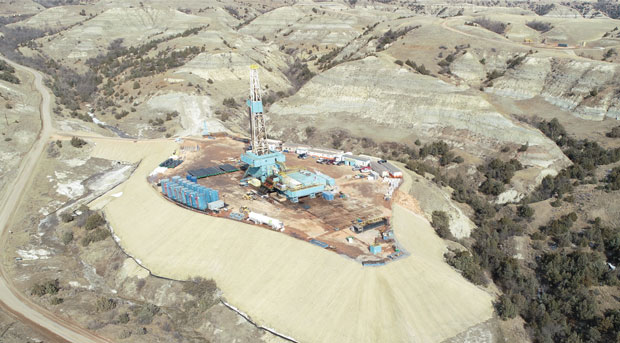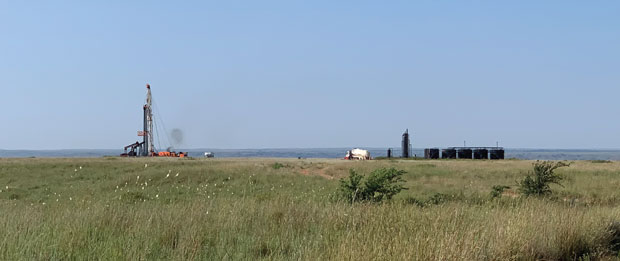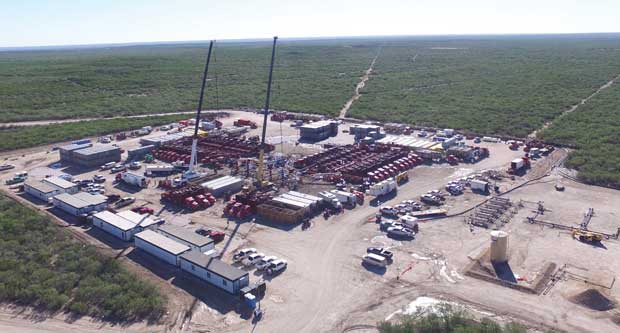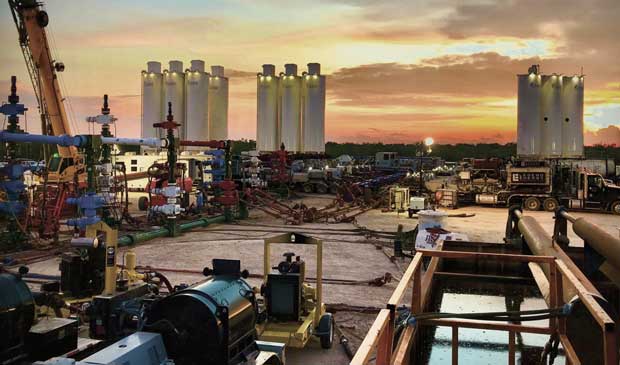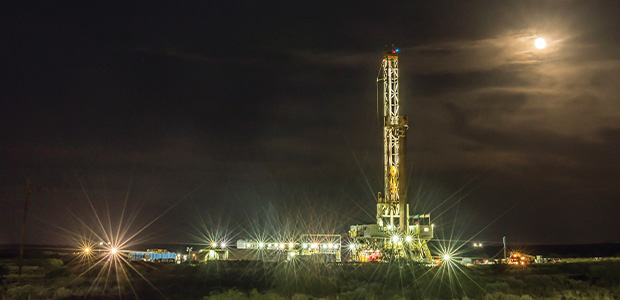
Industry Playmakers
Independents Of All Sizes Making Big-Time Moves To Position For Future
By Danny Boyd, Special Correspondent
With the downturn of 2020 at last in the rearview mirror, the outlook for oil and gas prices is bolstering confidence among independent playmakers. It is from within the ranks of the independents that the pioneers of onshore resource play discovery have come, and it largely has been the smallest among them–regionally focused private companies–that have led the ongoing activity comeback of 2021 in both shale and conventional basins.
However, their larger peers are positioning to join them, building off recent mergers, bolt-on acquisitions, and new partnerships to both bolster their asset bases and strengthen their corporate capabilities.
Prime examples are the “new and improved” Devon Energy, the 50-year-old new kid in the Permian Basin; Continental Resources, the Bakken and SCOOP powerhouse that is looking to repeat past success in a new lease position in the emerging Powder River Basin; and EOG Resources, the shale play pioneer that is setting new development economic standards by zeroing in on “double-premium” assets in the Delaware Basin, Eagle Ford and Powder River.
Stepping down a rung or two in corporate size, numerous smaller-sized players continue to make equally big moves–albeit on scales commiserate with the operational structures of their organizations. For instance, SilverBow Resources is actively seeking opportunities to expand its scope in the Eagle Ford through mergers and acquisitions, newcomer Merica Oil Company is rolling out a new vertical drilling program targeting conventional reservoirs in Kansas, and U.S. Energy Development is pursuing both operated and nonoperated partnerships in the Delaware as well as other basins.
Major Merger
Devon Energy Corp. has emerged as one of the Permian’s most prominent players after completing a “merger of equals” with WPX Energy in January, with the company retaining Devon’s name, Oklahoma City headquarters, and a blended board and executive team. The two companies’ portfolios overlapped in the Delaware Basin, where it is now a dominant leaseholder with some 400,000 net acres in the economic core of the play, but Devon also holds assets in the Anadarko, Eagle Ford, Powder River and Bakken.
After completing a merger of equals with WPX Energy in January, Devon Energy has emerged as a dominant player in the Delaware Basin, where it holds 400,000 net acres in the economic core of the play. Devon is active in the Anadarko, Eagle Ford, Powder River and Bakken.
When the deal closed, Devon Energy became one of the top five largest unconventional oil producers, with daily production of 580,000 barrels of oil equivalent and a capital budget of $1.6 billion-$1.8 billion. The majority of the CAPEX program is earmarked for the New Mexico and Texas portions of the Delaware, where Devon’s 2021 oil production is forecast to average 280,000-300,000 bbl/d.
This spring, Chief Operating Officer Clay Gaspar and his fellow executives are busy integrating the two heavy hitters into a better, larger Devon built to grow through the bit with an inventory of thousands of wells replete with a lengthy list of high-graded Delaware Basin prospects. Devon also has new economies of scale and structural efficiencies that are expected to save $575 million in annual operating costs, Gaspar says.
“We are in the early stages of really coming together as a team, but I think this investment and the time we are spending is an important process that will allow Devon to take a significant step up as we go forward,” he comments.
With both legacy organizations considered low- to no-growth companies focusing on generating free cash flow after periods of exceptional growth, the new Devon will generate consistent growth in the single digits and create long-term value for shareholders that also will benefit service company partners and employees, Gaspar points out.
While assuring that staffs are on the same page on formation names and the like, and ensuring the best of best practices and technical know-how, the company is combining teams that have proven their mettle on Devon’s legacy acreage in southeastern New Mexico and WPX’s former core position in Texas.
The fruit of their labors just prior to closing included 23 mostly Bone Spring wells brought on line in Devon’s legacy New Mexico acreage with 30-day initial production rates averaging 3,200 boe/d (70% oil) and 26 new wells in WPX’s legacy Stateline area in Texas targeting the Upper Wolfcamp and Bone Spring with average IPs of 2,300 boe/d (61% oil).
Now, the New Mexico team with expertise in the Bone Springs formation can be leveraged in Texas, where the play is emerging, Gaspar points out. Conversely, WPX’s Wolfcamp experts in Texas can work completions on the emerging Wolfcamp on the New Mexico side.
Differences in completion design philosophy are being worked out, he adds, including whether to use 100 percent 100-mesh sand or a mix of 40/70- and 100-mesh on laterals typically averaging 10,000 feet in length and frac designs ranging from 2,000 to 2,500 pounds of proppant per lateral foot.
Although 35% of Devon’s Delaware holdings are on federal lands in New Mexico, Gaspar says the company has been able to mitigate the risks associated with the U.S. Bureau of Land Management’s decision to impose a 60-day freeze on new permits in January, and feels it in a good position. Devon already had secured more than 500 federal drilling permits in New Mexico, which will provide drilling opportunities for years, Gaspar explains.
Devon also will continue to focus on the Williston, Powder River, Eagle Ford and Anadarko, which will complement its Delaware holdings as it looks to fund its base dividend and grow its variable dividend, according to Gaspar.
Assessments of potential asset acquisitions will continue, but the bar will be high, he emphasizes. “Just because we are actively in conversation and showing eagerness to evaluate new ideas, we also have to reflect back in the mirror and make sure it is truly accretive to the story we have,” Gaspar remarks. “That is the interesting balance that we play. I would not rule out any of those basins as places for future deal potential.”
Powder River Position
After closing in March on a $215 million purchase of 130,000 net acres from Samson Resources II in the Powder River Basin, Oklahoma City-based Continental Resources Inc. plans to do what it typically does in new plays: apply what the company has learned elsewhere and take reservoir performance to the next level, says President and Chief Operating Officer Jack Stark.
Armed with 96 approved federal drilling permits, Continental, which will spend approximately $80 million in the Powder River this year, is deploying two rigs to begin delineating and developing the Shannon, Frontier and Niobrara reservoirs in Campbell, Converse and Johnson counties, Wy., he details. Future targets include the Sussex, Mowry and Muddy formations.
After closing in March on a deal to purchase 130,000 net acres in the Powder River Basin, Continental Resources is earmarking $80 million to begin delineating and developing multiple stacked reservoirs, focusing initially on the Shannon, Frontier and Niobrara, but with an eye on future targets in the Sussex, Mowry and Muddy formations.
Multiple stacked reservoirs, within a 5,000-foot interval, are 70%-80% oil and in the early stages of development, Stark says. The acquired acreage is 80% held by production and came with 9,000 boe/d in production.
“When you step back and take a look at the properties, three out of the top five oil-producing wells in the basin are located within our acreage block, all with 30-day IPs of more than 2,000 boe/d, and two of those were operated by Samson,” he points out.
The Ogalalla No. 40-75SH posted an IP of 2,235 boe/d (94% oil) and the Spearhead 75SBH produced 2,184 boe/d (98% oil), both from the Shannon, according to company information.
Well construction is similar to properties in the Bakken and Oklahoma, says Pat Bent, senior vice president of operations. True vertical depths range from 10,500 to 13,500 feet with two-mile laterals and the potential exists for longer ones utilizing the same technologies and approaches, he adds.
“Our long history of operational excellence in all of our operating basins gives us the confidence to be best in class. This is another opportunity to deploy that capability,” Bent says.
During the first quarter, Continental worked to integrate operations with plans to deploy the first rig in May and the second in June, he says. For the year, 15-17 Powder River wells will be spudded with up to 10 completions in the play, he elaborates.
Despite the BLM permit freeze, Continental’s leadership does not see impediments to drilling, he says, and is encouraged by recent permit approvals.
Continental will continue to rely on steadfast, repeatable performance in the Bakken, where the company plans to spend 60% of its $1.1 billion drilling and completion budget, Stark says. “Bakken performance has probably the best repeatability of any play in the country right now, and we are very pleased with what we have there,” Stark says.
Continental has enough overall drilling inventory to grow the company at a 5% compounded annual growth rate over the next 10 years considering its holdings in the Bakken, Oklahoma and now the Powder River, he says.
The company already has lowered debt beyond initial guidance, to $4 billion from $4.5 billion announced earlier, Stark says. About 58% of cash flow scheduled for reinvestment, including 35% in the Oklahoma SCOOP play, where the company’s SpringBoard projects are on track, he says.
“We are an exploration company and SCOOP is an example of that, and so is our core position in the Bakken,” Stark says. “The reason we have such sustainable and repeatable results is because with the geology and our early entrance, we have a huge position in the core of the assets.”
Double-Premium Assets
Throughout its operational footprint, EOG Resources Inc. is high-grading locations to select properties for development that are considered “double-premiums” that boost returns and cash flow, says CEO William R. “Bill” Thomas.
Premium properties in the Delaware Basin and Eagle Ford are being targeted, but the company also is increasing activity at Powder River Basin as the Wyoming play enters a new phase of development.
EOG expects to spend $3.7 billion-$4.1 billion this year to maintain oil production at 440,000 boe/d and complete approximately 500 net wells as it continues to increase shareholder value and returns with a focus on wells that generate a 60% rate of return at $40 oil, Thomas explains.
“We are leasing and testing on some of the new plays that we have been developing over the past few years, and those are very high-impact plays; double-premium kind of plays,” he told investors at an Evercore conference in March. “We are set to generate an enormous amount of free cash flow–$2.4 billion at $50/bbl (WTI)–obviously, a lot more at $60/bbl. We have already increased the regular dividend by 10%.”
In the Delaware Basin, EOG plans to average 14 rigs and four frac crews in 2021, with plans to bring 275 wells on line by year’s end on its 404,000-net acre position in West Texas and southeastern New Mexico, according to company information. A well cost reduction of 5% is targeted in the Delaware, where the company boosted production by 10% last year. Altogether, EOG has 6,300 net undrilled locations in the Delaware.
In the Eagle Ford, EOG is keeping three rigs and two frac crews busy, with plans for 145 completions this year. It has 1,900 premium undrilled locations in the play.
Thomas notes that a lot of the company’s growth over the past decade came from the Eagle Ford, which although a more mature play now, still has substantial inventory, including multiple double-premium properties.
After continuing to delineate plays and install infrastructure along development corridors to reduce costs, EOG is running two rigs and one frac crew in keeping with plans to complete 45 net Powder River wells tapping into the Parkman, Niobrara, Turner and Mowry formations.
If the company meets its well cost reduction target of 9% this year in the Powder River, the costs will have been cut by 25% since the beginning of 2019. New completion designs have increased average cumulative production from a Niobrara well by 45% and 70% from a Mowry well. EOG has been increasing activity, including building out infrastructure on federal lands, Thomas says.
Given recent statements from the Biden administration, the company’s current existing federal leases and corresponding federal drilling inventory can be fully developed, he says. “EOG is well prepared to manage through any regulatory changes that can impact the pace of development on federal acreage,” Thomas relates. “The combination of our large number of federal permits in hand, our flexibility to pivot within our deep inventory of double-premium locations and our ability to add new inventory through organic exploration gives us the confidence that the future performance of the company will not be affected.”
Seeking To Scale Up
With the operational flexibility to quickly shift drilling and completion activity among crude oil, liquids and dry gas assets in the Eagle Ford, SilverBow Resources Inc. is refocusing on oil drilling in keeping with plans for 5%-10% annual growth, says CEO Sean Woolverton.
However, in a basin in need of consolidation, the Houston-based company is looking beyond expansion solely by the drill bit, he adds.
With the operational flexibility to quickly shift drilling and completion activity among crude oil, gas liquids and dry gas targets in the Eagle Ford, SilverBow Resources Inc. is focusing on oil drilling to achieve 5-10 percent annual growth and actively looking for merger or acquisition opportunities.
“We recognize the need to scale up the company to get the benefits that come with it,” Woolverton says. “As a result, we are actively looking for a transaction, whether a merger or acquisition, involving a large asset base.”
A prominent player in South Texas since predecessor Swift Energy entered the region about 30 years ago, SilverBow has grown its footprint in recent years mostly through bolt-on acquisitions near existing leases that typically ranged 300-1,500 acres, he reviews. Larger available tracts in the South Texas play are hard to come by, Woolverton says.
At the start of 2021, SilverBow held just over 155,000 net acres and planned to concentrate efforts on dry gas drilling, but with rising oil prices the focus has shifted to oil drilling in northern McMullen and Southwest LaSalle counties, where a reactivated rig likely will spend the rest of the year, he says.
“We may drill a couple more gas wells but our returns get better with higher oil prices,” Woolverton says.
On its McMullen acreage, where two-thirds of reserves are oil, the company brought 10 net wells on line in 2020, completing four wells with laterals over 10,000 feet long. Historic IPs at McMullen have been 750-1,200 boe/d, he says. At its Artesia acreage in LaSalle County, where production is roughly in thirds of oil, liquids and dry gas, SilverBow has experienced peak IPs ranging from 850 to 1,250 boe/d, Woolverton adds.
Completion designs generally include 2,000-2,500 pounds/foot using a hybrid design with slickwater and some gel pumped in 150-200 foot stages, he details.
Despite the early focus on oil, the company remains bullish on natural gas, Woolverton says. He estimates overall 2021 production of 180 MMcfe/d-200 MMcfe/d, up 4% year-over-year, with natural gas representing 79% of output.
In December, SilverBow brought on line a second, six-well La Mesa pad in Webb County along the Mexico border after completing an initial six-well pad on the property in late 2019, he explains. Initial production on the new pad is consistent with the first pad, which produced about 100 MMcf/d in the first month of operations, from both the upper and lower Eagle Ford, Woolverton says.
Altogether, the company has a producing inventory of about 350 gross operated wells and 400-500 identified undrilled locations, equating to roughly a 10-year inventory, Woolverton says. SilverBow’s capital guidance includes $100 million-$110 million with a strategy of reinvesting 70%-80% of cash flow.
Opportunistic Mindset
Franz Ronnie and his partners in Merica Oil Company LLC place value on being visionaries with an opportunistic mindset. The team is planning five workovers and up to 10 new vertical wells this year on legacy acreage in the Central Kansas Uplift and Hugoton Embayment of the Anadarko Basin.
Collectively, they plan to install up to 50 new drills over a three-year period. According to Ronnie, the company’s strategy was made possible by the COVID-induced downturn, which allowed low entry costs in Barber, Comanche, Rooks and Rawlins counties in Kansas. Because of the low entry cost, Merica Oil was able to build a drilling portfolio on 3,500 acres, Ronnie explains.
Merica Oil Company has five workovers and up to 10 new vertical wells scheduled to drill this year on legacy acreage in the Central Kansas Uplift and Hugoton Embayment of the Anadarko Basin targeting the Cherokee Sands, Kansas City-Lansing, and Arbuckle.
“I think there is a lot of opportunity there and so do my engineers and geologists,” Ronnie remarks. “We can do an authorization for expenditure for $380,000-$500,000 to drill to 4,800 feet.”
Furthermore, Robert Rother, Merica Oil’s reservoir engineer and partner, reports, “Our current wells in Barber and Comanche counties were drilled in the mid- to-late 1990s and will be enhanced by planned workovers beginning in May that include pulling tubing, acidizing to clean up wellbores and perforations, and performing some smaller hydraulic fracturing to enhance current production.”
Ronnie says he plans to deploy a meticulous assessment of pay zones up hole, including the Cherokee Sands and the Kansas City-Lansing, for recompletion prospects.
“Analogs and the positive experience of other operators in the area give reason for optimism,“ Rother adds. “Costs for workovers are targeted at $50,000-$60,000.”
Although potential pays can include brine, Merica Oil has two saltwater disposal wells and plans to drill three others, Ronnie reports. Its existing gas sales are through a ONEOK pipeline.
“In Rooks County, where two-three new drills are planned, company wells produce primarily oil from the Kansas City-Lansing, have some Arbuckle potential and produce less water,” Rother says.
With 3-D seismic data in hand, Merica also is confident of identifying structural traps to exploit in Rawlins County in the Northwest corner of Kansas.
According to Ronnie, new drilling is scheduled to begin in July after workovers are complete. With the company assessing drilling prospects in light of workover outcomes. Merica Oil continues to look for available acreage.
“If we feel we need to go get more acreage in different areas, we will do that to improve economics for the investor and the company,” Ronnie reports.
Building Partnerships
U.S. Energy Development Corp. will spend north of $100 million this year on operated and nonoperated opportunities with an eye on building on its existing position in the Delaware Basin and elsewhere, says Chairman and CEO Jordan Jayson.
The private company based in Arlington, Tx., has more than 100,000 net acres over 10 states, and is open to investment opportunities and asset acquisitions in the Permian, Eagle Ford, Powder River and Denver-Julesburg Basins. However, the Delaware is the primary target these days, he says.
“We are always looking for proved, developed and nondeveloped reserves. While it is a very competitive environment, we are seeing great opportunities with proven operators in the Delaware and are looking to partner with and provide development capital for these companies,” Jayson says.
The company already participates as a nonoperator with major oil companies drilling and producing in the Permian Basin, in addition to operated positions in the Delaware Basin and Eagle Ford, he details.
U.S. Energy Development Corp. will spend more than $100 million this year as it build its partnerships in operated and nonoperated projects across its 100,000-net acre leasehold in 10 states, including nonoperator participation with major companies in the Permian Basin in addition to operated positions in the Delaware and Eagle Ford.
“We are always focused on finding the best projects to provide the best returns for our investors,” he says. “Often this is predicated on the current A&D and commodities markets. For example, this year we are seeing great projects on both the operated and nonoperated side and are continuously pursuing both.”
Altogether, the company has 5,000 boe/d of operated production and total production approaching 10,000 boe/d, he says. This year, U.S. Energy Development will participate in more than 25 wells between operated and nonoperated properties, Jayson says.
In addition to interests in properties in Eddy County, N.M., productive of the Bone Spring and XY sands, the company’s operated acreage in Ward County, Tx., is productive from the Lower A and Upper B Wolfcamp, he details.
Laterals extend longer than 7,500 feet on average, and depending on bench, are completed with 2,000-3,000 pounds of sand per lateral foot and 35-55 barrels per foot of slickwater. Spacing is between 750 and 1,200 feet, with the trend in the last six months toward greater spacing in the basin, Jayson says.
IPs have been higher than 700 bbl/d and over 1 MMcf/d of wet gas on a recent three-well pad in Ward County producing from the Wolfcamp B from laterals just under two miles, he adds.
At prices in late April, U.S. Energy Development has more than 50 Permian locations in its inventory and another eight on its operated position in the Eagle Ford, Jayson says.
For other great articles about exploration, drilling, completions and production, subscribe to The American Oil & Gas Reporter and bookmark www.aogr.com.


